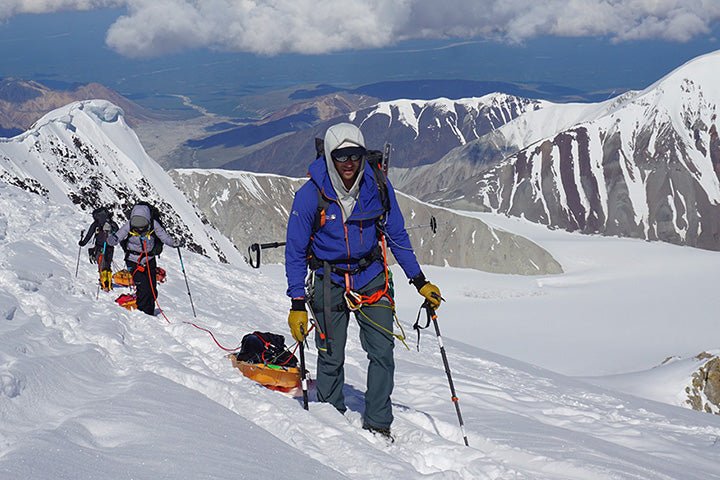The Crux Series - Guiding Denali with Wyatt Evenson

THE CRUX SERIES
GUIDING DENALI

WITH
WYATT EVENSON
The Crux Series is a collection of interviews with mountain experts that have a wealth of knowledge about each of the peaks in our glasses. In support of the launch of our Denali collection in Alaska, we connect with Wyatt Evenson, who’s passion for mountaineering led him to a professional carer guiding others to the highest point in North America.
An accomplished climber and professional guide, Wyatt is originally from Washington where he was introduced to mountaineering at a young age. He now splits his time between Utah, Montana and Alaska. Wyatt has guided seven different groups to Denali’s summit over the years as the Alaska program coordinator with the American Alpine institute (AAI). The organization was founded in 1975 and is dedicated to helping climbers raise their skills, protect the environments in which they climb, develop good judgment, and safely gain access to the great mountains of the world.
Wyatt has a vast knowledge of Denali and the unique challenges those looking to reach the summit may encounter. For someone who chose a career in the mountains Wyatts modesty is a breath of fresh air. Dig in as we discuss his experience in Alaska and much more.

Denali
Understanding the vast landscape of Denali is difficult. To better grasp the majestic expanse we've created an interactive Google Earth experience that allows you to immerse yourself in the West Buttress Route that Wyatt has much experience on. This virtual tour starts at the airport in Talkeetna and using the arrow keys on your keyboard you can navigate all the way to the summit. You may need to download the Google Earth app on your device to view this, but trust us... it's worth it.
Pro Tip: Hold Shift or Command to look around and drop the Street View person on a dot for some unreal first hand interactions at some of the camps.
HOW WERE YOU INTRODUCED TO CLIMBING?
Mountaineering was always a big thing in my family. Both my dad and uncle were avid climbers, they're pretty humble guys so they wouldn't call themselves super accomplished mountaineers. It was something that was always stable in my family and something that we were all interested in. I don't think anybody really knew there was potential to make a living out of it.
During college while I was working at an outdoor retailer I invested in a 12-day mountaineering program. It helped to show what it's like to be a guide and gave you a general sense of the profession. Obviously, that was a pretty sobering 12 days but overall I did pretty well and had a great experience.
HOW WERE YOU FIRST INTRODUCED TO DENALI?
When I graduated college, I wasn't really sure what I was going to do. A lot of my friends were off gallivanting around Europe and South America, and I felt like I've got to do something a little bit more unique. I had heard about Denali and was always attracted to it. It was always in the back of my mind. The group who led the mountaineering program approached me shortly after and said "Okay, great. You did good. If you have the time and the resources, why don't you go ahead and try Denali?" So I figured let's keep doing this and see what happens. I was fortunately able to get a whole month off work and already had a lot of the gear.
When you first see Denali, you almost don't believe it's real because it's so large. And then you learn it’s the third biggest mountain in terms of general prominence. It's almost 10,000 feet shorter than some of the bigger peaks in the Himalayan, but nothing really compares to the general size. There's definitely a factor of intimidation at first. Your first reaction is, "What have I gotten myself into?" and “Actually, this might be a little bit harder than I thought it was going to be." You immediately give it all the respect it deserves. Fortunately, I got to the summit on my first trip. Denali's one of those mountains that will chew you up and spit you out, but it'll also give you some of the best experiences that you can have. Just talking about it now gets me fired up mainly because when I think back to that very first trip versus now, I’ve come so far in so many ways .

HOW WAS THAT FIRST EXPERIENCE WITH DENALI?
There's just so many things that pile up for you. I don't think I was really prepared for that. I had done a lot of really long multi-day trips before, but I don't think anybody really understands how remote Alaska is until you're there. The only way to access it is by bush planes. There's a few flight services that are based in Talkeetna, that's about a 45-minute flight. I'd say 75% of people say that their favorite part of the trip is just flying into base camp and then flying back out. But then when the plane drops you off there with three weeks worth of stuff, your first reaction is, "Whoa. This is pretty hardcore."

Views of Mt. Foraker from base camp
My first time was a 20-day trip which is just about the overall average to have a successful trip. I've never really been in an area where it can be absolutely perfect weather one day and then the next day it’s snow and blizzard, and you think to yourself, "Why am I here? I got to go home." That's how it was. Fortunately, we had a day that sandwiched in between about four or five days of really bad weather. There was just a perfect day that we were able to get up and, fortunately, get back down over the course of two days
.
WHAT LED YOU INTO GUIDING PROFESSIONALLY?
On that first summit of Denali I had a great crew, learned a lot about myself as a person, a mountaineer and as a climber. I loved the mountain and had a great experience. I knew 100% this is what I wanted to do with my career. Fortunately, I was able to transition into more of an office role to start with the American Alpine Institute that's based in Bellingham. From there I was able to work myself into a guide role pretty fast. They have a great reputation and are really involved in the community in western Washington. Eventually I was a guiding full-time before transitioning into the operational role with our Alaska program.

Wyatt leading the group to high camp
WHAT DOES YOUR DAY TO DAY AT AAI LOOK LIKE NOW?
Most of the day is just talking to people about Denali and my experiences. I try to promote our Alaskan expeditions and help people be in the best position to succeed while they're up there. We run anywhere from five to eight expeditions per year. I do all the food purchasing and transfer everything up there, trying to find the less expensive, more efficient ways to have everything ready. That way, when our first trip of guides arrive, they can pack for their trip, go on the mountain, and from there it's just a trip every single week. I do the last trip of the year every year just to make sure that the broom comes through and everything gets ship shape.

The rugged Alaska Range
WHAT IS UNIQUE ABOUT AAI?
At AAI, we're a mountaineering school first and a guide service second. That's how I really want people to do it. People might bash our business model a little bit because we're training people to not need us. People, to a certain level, want that independence. They want to strive for competence to make those decisions on their own. You need to be a competent mountaineer while you're on Denali.

Reaching Camp 3
WHAT KIND OF PHYSICAL TRAINING GOES INTO A DENALI TRIP?
If you want to be really good walking uphill with a heavy pack on, you've got to walk uphill with a heavy pack on. That's just the way it is. I'm very fortunate to be able to live in Utah in the winter and in the spring where I can just put on a heavy pack and walk uphill. But we get a lot of people who are from flatter parts of the country and they ask, "What the hell do I do?" We have to find some unique ways to make sure that they're in a decent position to be able to do it. But as I always say, "You have to simulate walking uphill with a heavy backpack on. That's the only thing that's going to set you up for success. We have to be a little bit unique in terms of our overall training. But I really say to be good at something, you've got to do that as much as you can.
WHAT IS THE CRUX OF THE CLIMB?
There’s always a few, you might think, "I've got this whole thing down. I know all the problems that are going to arise." And there's five problems I would have never even thought of that come up on top of that. The West Buttress on Denali is not technical, for the most part, it's pretty standard mountaineering. The primary factors that make it different are, one the altitude, the cold, and the weight of your pack. That's probably the thing that crushes people the most. It's a 75-pound pack of all your gear, plus another 50-pound sled to tow. So there's a high level of physical fitness that comes into it and is needed to even get through day one.

Heavy packs and sleds on a long traverse
The summit day is probably the most physically demanding day and certainly the longest, usually about 12 to 14 hours. It is just filled with so many hazards. Getting on the summit ridge and going to the top, though, there's no better feeling. It's a full 360-degree view. You know you're going to stand on top of North America. But for me, the most difficult is moving from Camp 3, which is 14,200 feet to High Camp at 17,200. It really challenges people. Typically, we don't take people to high camp unless we're pretty certain that they're going to get a summit chance. We have to really limit our time up there because you start to feel the altitude significantly more. People who spend more than four or five days up there just have issues.

Wyatt (Pictured Right) at High Camp
WHAT IS THE CRUX OF GUIDING ON DENALI?
You never really feel safe on Denali, I think, is the big thing. You can be content, but when we get to camp, we're on this huge mountain on a huge glacier where if somebody takes 10 steps off the wrong direction, they can fall and get hurt bad. These are nine people who you've never met before. You don't know what their backgrounds are. All you know is what's on paper. And then you share a tent together for three weeks and share every meal together and walk together. So to me, sometimes that can be tough. I think that's really difficult, just trying to make sure that the team meshes and just making sure that they have fun. That's what I always tell people. If you're not up here having fun, you really shouldn't be here. I have to remind myself of that too. Being focused on the overall goal, but also making sure that you're enjoying your time while you're up there.
As I always tell people, anybody can put up with anything for 24, 48, even 72 hours. I mean, I can have my in-laws for 72 hours and probably be okay. But it's right around that five-day mark when you really start to see people mentally deteriorate. Everything's new and fresh. It might be cool for the first three or four days. But by the time you hit day six, it's like, "Man, I really miss the toilet. I really miss just being able to turn my stove on. I miss my coffee. I miss my dog." Whatever it might be.
I can remember when I was in that position when I was at High Camp and the weather wasn't really good. I asked the guides "What's the weather looking like? What's our summit chance?" And they said, "Well, probably less than a 10% chance." And then the feeling of, "Man, I just wasted all this time, paid all this money. Now I'm not going to get a shot at this." So for me, I feel like that helps me be more successful as a guide to remember humble origins, humble beginnings. Let's do the best we can to make sure they have a chance to fulfill their dreams, too.
WHAT'S THE MOST REWARDING ASPECT OF GUIDING?
I had a really interesting trip this year to the summit with a client. We got to about 19,400 feet and he was having a tough time acclimatizing. He didn't eat very well the night before. He sat down and said, "I don't really want to go any farther." I stopped and had a chat with him, “If you go all the way back down to base camp, you're going to be mad at yourself for a very long time. So let's just take a few minutes, relax, we're going to be behind a few people, but that's okay. Let's just do this." We could see the summit not very far away. I just gave him as many bars and candies as I could, and I said, "I tell you what. You're going to regret this if you don't at least try." Fortunately, he felt better and got up. It was really interesting to see just how emotional he was when he actually got on the summit after giving it another try. That was probably one of the more rewarding times for me on the mountain.

Making the final push to the summit
WHAT KEEPS DRAWING YOU BACK TO DENALI AFTER ALL THESE YEARS?
The conversations I have with really great individuals who are coming to AAI and trusting us to give them the best experience possible while giving them an opportunity to summit. I get caught up in it a little bit and I start talking about all the great times I had, and it makes me want to forget the times that were really difficult. And that's what brings you back, it's such a great challenge, to be honest. As I said earlier, you go over every problem that you can think of and all the solutions to them, and then just this last trip alone, there were probably three issues where I thought, "I don't know what to do." And I think that's good. You have to be able to be exposed a little bit at times and make a mistake here and there to really grow and get better at what you're doing.

WHAT'S NEXT FOR YOU? ANY PERSONAL CLIMBING GOALS?
With Denali, our 2020 season got canceled due to COVID, so we have around 30 individuals who have been postponed for three years. I'm really looking forward to 2022 and excited for a lot of the individuals to get up there and do it.
Personally I have some climbs I want to accomplish in northwest Montana, which is home. That's my absolute favorite place to be, I would be there all the time if I could. There's a lot of really remote peaks there in an untouched independent range. So yeah, I do have a lot of those. For me, I need to detach myself sometimes because a lot of people get caught up in doing these classics in Alaska and doing all the stuff that's in the books. And for me, I'm one of those guys that's like it could be a simple hill, and if there is no one one it, I'll be totally fine. In the least egotistical way to say it, there's always things I would really like to do, especially before it’s too late, as a lot of these routes are starting to melt out and go away with the changes. There's a lot of stuff in Alaska I'd really like to do.
ANY ADVICE FOR SOMEONE WHO WANTS TO GET INTO MOUNTAINEERING OR POTENTIALLY CLIMB DENALI?
I'd say like everything, make sure you're doing it for the right reasons. Denali, as a seven summits, attracts some of those people who’s entire ego and existence is built into summiting. We are trying to constantly remind individuals that there is weather and other circumstances that play into it. You might not summit, and you have to be okay with that in a lot of ways. So I'd say that's always the biggest thing is just make sure that you're doing it for the right reasons. If you want to do it for ego, that's fine. But I don't think you're going to have much fun while you're doing it. Just make sure that you're having fun, that you're respecting the mountain and the environment that you're in.



